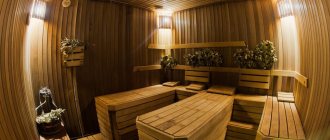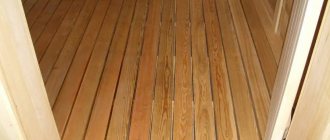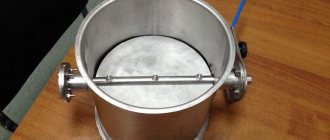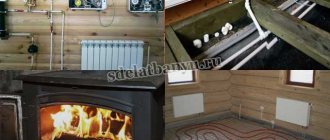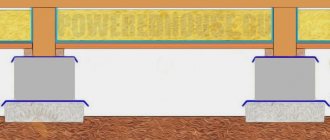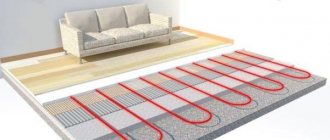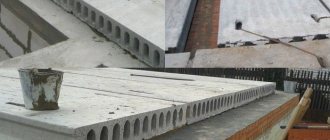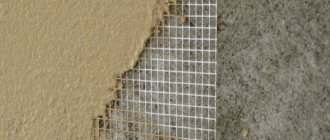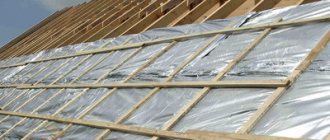The technology and process of arranging floors in a steam bath and washing department differ significantly from the principles of constructing floors in residential and commercial buildings.
To ensure an effective system of drainage, ventilation, water and thermal insulation, it is necessary to adhere to the basic rules of installation. A properly equipped bathhouse floor ensures rapid removal of wastewater and maintains the microclimate in the room.
Often the floor for a bathhouse is made of wood or concrete. It is difficult to determine which floor is better, since each type of base has its own operational features and characteristics that should be taken into account when arranging a private bathhouse.
Types of floors in the bathhouse
Let’s start with this, because the durability of the structure, its relationship with sanitary and hygienic standards depends on the correctly chosen material, and we don’t forget about aesthetic aspects. In fact, there are not so many building materials from which bath floors are made. Because the specific operating conditions of the bath space do not allow the majority to be used for purely hygienic reasons. Of course, we also have to take into account the environmental friendliness factor.
Hence there are only two materials: concrete and wood in the form of lumber. Therefore, we will consider both options and decide on their pros and cons.
Wooden bath floors
Wooden flooring is the traditional flooring in Russian baths. Wood has been used since ancient times, but even today it has not lost its relevance. True, we must pay tribute to modern construction technologies, with the help of which the durability of the floor structure has increased, as well as such a modern indicator as thermal insulation.
Wooden floors in the bathhouse Source 2proraba.com
Now the question arises, which board to use for the floor in the bathhouse. The answer is obvious - made from durable wood species with a dense structure. That is, which practically does not absorb moisture and water. Of all that the modern market offers, these are oak, larch and alder. Let’s make a reservation right away: oak boards are not a cheap material. And it’s not always possible to find them. In any case, using them in a bathhouse is the height of wastefulness.
Therefore, larch and alder remain. Both options have high wear resistance. Moreover, the structure of the tree is so dense that the hygroscopicity of the material is practically zero. But even in comparison with others, these two far exceed them in terms of price. Therefore, most country developers purchase pine boards, which they use to cover the floors in bathhouses.
This is one of the cheapest materials with low technical and performance characteristics. Hence the short service life and reduced durability. That is, the characteristics fully correspond to the price. And when the boards are completely out of order, it will not be a pity to say goodbye to them.
Pine boards for the floor in the bathhouse Source stblizko.ru
So, having figured out the floor for the bathhouse – which boards are best to use – let’s move on to other parameters. The first of them is the moisture content of the material. Here it must be said this way - the drier, the better. Boards with a moisture content above 12% cannot be used in floor construction. When they come into contact with moisture, they simply begin to swell, warp and deform.
As for the thickness of the board, there are no special requirements. The thing is that this parameter only affects the step between the lags. Eg:
- if a board with a thickness of 25 mm is selected, then the step between the logs should be 40 cm;
- if the thickness is 40 mm, then the step is 60-70 cm.
Design features of wooden bath floors
It all depends on the room in which the floors are laid. For example, if this is a washing machine, then there are two options:
- solid;
- leaking
The first is a structure made of tongue-and-groove boards, which are connected to each other with a tongue-and-groove lock. The result is a continuous flooring without gaps or cracks. Such flooring must be laid with a slight slope towards the drain. The latter is either a gutter or a hole in the floor connected to a drainage pipe. The hole is usually covered with a grill.
Solid floor in a bathhouse with drain Source i.pinimg.com
The second is flooring, in which gaps are left between the boards. Through them the water goes down and further into the drainage tank.
It should be noted that the solid option implies the assembly of a traditional plank floor at an angle of no more than 5%. This is a slope within 50 mm per 1 m of the length of the board used. It is this angle that creates a safe place for people to be on a wet surface, on which soapy layers often remain. Therefore, when the question arises, which bath floors are better, this should always be taken into account when using wood.
Let us add that solid floors are no different from leaking floors in terms of assembly complexity. In both cases, the strength of the overall structure must be taken into account. But today solid floors are approached from the point of view of insulation. That is, they try to lay thermal insulation material under them, thereby reducing heat loss through the floor base. Let's look at how to make a floor in a steam room in a wooden bathhouse in the form of a continuous flooring with insulation.
Bathhouse with a leaking floor Source srubok.rf
See also: Catalog of projects for wooden, reinforced concrete and stone baths.
Formation of a solid floor
You need to start by laying the joists. Do not forget that the solid floor in the bathhouse should be laid at an angle. To create it, you have two options:
- Install the logs at the required angle.
- The upper surface of the joist is trimmed at the required angle.
The second option is a little more complicated in that it is not easy to cut the boards exactly. An experienced craftsman is required here. Or another option is to cut the boards in a carpentry shop. But it's more expensive.
So, if the logs are laid correctly, it is necessary to form planes on which the insulation will be laid. To do this, cranial bars are packed along the lower edges of the logs. How this is done can be clearly seen in the photo below.
Insulation scheme for a wooden floor Source vsebloki.ru
Next, substandard boards or other flat wood material are laid on the bars. For example: plywood. The resulting niches are covered with rolled waterproofing material, on which insulation is laid. From above, the entire structure is covered with another layer of rolled waterproofing, and then they proceed to the installation of tongue-and-groove floor boards.
Now a few words about how to properly make a floor in a steam room, assembling it from tongue-and-groove boards:
- The first board is laid near the wall, leaving a gap of 8-10 mm. This is a compensation gap that will compensate for the moisture and temperature expansion of lumber. Laying is carried out with a spike towards the wall. For fastening to the joists, galvanized or stainless steel nails or self-tapping screws are used. The fastening is carried out in the groove of the board so that the caps of the fasteners remain inside and are not visible from the outside. The first board is also attached to the joists at the edge located near the wall. The caps will subsequently be covered with baseboards.
- Parallel to the laid board, at a distance of the width of the boards used plus 50 mm, a wooden strip with a cross-section of 50x50 mm is laid and attached to the joists.
- Lay the second board, inserting the groove into the tenon of the first board.
- Pre-made wooden wedges are driven between the second element and the batten, with the help of which the second board is tightly pressed to the first.
- The second element is attached to the joists through a groove.
- Dismantle the rail and move it to the required distance. And the whole process takes place in the same sequence. The last board is attached not to the groove, but to the edge perpendicularly.
How to insulate
The floor is insulated during the construction stage, but this is already understandable. There is no way to insulate a torrential one with water draining under the bathhouse , but with the rest it’s already better.
Usually the insulation is placed on a layer of waterproofing (do not forget that it must be sealed and extend onto the walls). This can be polystyrene foam, expanded clay, or any other insulation material that can be poured on top with concrete and it will not lose its thermal insulation properties.
Also, for insulation, it is worth taking measures to seal the underground space - there should be no cracks or holes. But at the same time, if not necessary, then it is very desirable to have vents in the base, which should be closed during procedures, but in general are an important part of ventilation.
There is another option for how to insulate the floor in a steam room. A concrete screed or a clay castle is not always made. Therefore, the insulation can also be placed on boards that are attached to the bottom of the logs. That is, the logs are first attached to the foundation frame or grillage, then the cranial bars are nailed, boards are placed on them, a water barrier in the form of a film is placed on them, for example, and the space between the logs is filled with insulation .
It would be worth putting another layer of water barrier on top of the insulation, because water can penetrate from above. Next is the rough floor, and whitewash on top of it. At the same time, we must not forget about the slopes leading to drainage. This option is shown in the picture above. It goes without saying that the drain pipe is brought directly to the level of the finished floor, and the entire wastewater drainage system is done during the laying of the foundation (if it is strip) or later (if it is columnar or pile).
Here's another option in the video below.
Well, the surest way to make walking on the floor comfortable in any frost is to install electric heating. Most often this is done if the owner is laying ceramic tiles.
More detailed material about floor insulation in a bathhouse is here.
Video description
The video shows the technology for assembling a solid plank floor:
See also: Catalog of companies that specialize in building baths, repairing foundations and installing fireplaces and stoves.
Formation of a leaking floor in a bathhouse
Before making the floor in the steam room in the form of a leaky flooring, it is necessary to form the floor under the boards. After all, the boardwalk is laid with gaps between its elements. Because the water must flow down, collect there and be discharged outside the bathhouse or go deep into the ground. Therefore, several options are offered:
- The top layer of soil under the wooden floor is removed before installation. Instead, crushed stone up to 50 cm thick is filled in. Sometimes a hole with a diameter and depth of 1 m is made in the center. This is also covered with crushed stone. The negative side of this design is that soap and water gradually fill the crushed stone layer, which is why an unpleasant odor begins to appear from under the flooring.
- If the bathhouse was built on sandy soil, then you don’t have to fill it with crushed stone. The drainage qualities of sand are already known to everyone.
- The most difficult option is to arrange a drainage pit, which is located away from the bathhouse structure. To do this, they not only dig and equip a hole, but also make a ditch or lay a pipe up to it. They also carry out concrete work under a wooden flooring with a slope towards the drainage structure. That is, when water gets under the floor, it falls onto the concrete surface and moves by gravity towards the drainage ditch, and then into the cesspool. An excellent option that provides complete isolation of the bathhouse from the sewerage system. But in terms of the cost of construction work, it is the most expensive.
Forming a foundation under leaking floors Source spbmasterstroy.ru
Attention! Some craftsmen recommend reducing the cost of the process of forming a concrete base. To do this, instead of concrete, a layer of fatty clay is laid. It does not allow water to pass through itself well, so there will be no problems with the drainage of the latter.
As for the construction of a wooden floor, the logs are laid with their ends either on the foundation of the bathhouse, or columns of blocks or bricks are erected under them. The process of installing floorboards is simple, because it does not require precise adjustment of the elements to each other. After all, a gap of at least 5 mm should be left between them.
Some craftsmen recommend making the flooring removable. That is, the flooring itself is made in the form of panels, which are simply laid on the joists and are not attached to them. This is done so that, if necessary, the shields can be removed and taken outside to dry. It will also be easier to carry out work under a plank floor if, for example, it is necessary to clean a drainage layer or a concrete base with a drainage ditch.
Removable shields on the floor in the bathhouse Source stroypomochnik.ru
So, what good can be said about a leaking field in a bathhouse? Almost nothing. All efforts to insulate them did not lead to a positive result. Therefore, it is impossible to take water procedures in such a bath in winter. A draft from below will definitely lead to colds. Therefore, it is recommended to use such a room in the warm season.
Is it worth combining a sink with a steam room?
At the design stage of the entire structure of the bathhouse, you need to decide whether you want to equip a steam room combined with a sink, or a separate one. Although, in fairness, we note that such a decision may be dictated not so much by wishes as by objective necessity.
The following factors are important in this matter:
- material capabilities of the developer;
- availability of building materials and other components;
- area of the building plot.
Often, a steam room combined with a sink is equipped when there is a lack of free space and funds.
In any case, even with a small building area, there will be at least two rooms in it. In the first - the dressing room - there will be a locker room, a rest room with the necessary furniture, as well as part of the stove, which will be heated from here. You can choose the design of the relaxation room in the bathhouse in advance. The second room is the washing-steam room itself. A heater is laid out in it, which provides heat, beds are installed, as well as a place for bath accessories - brooms, basins with cold water. Hot water is heated on a stove in a large container.
Despite the apparent inconvenience, a number of positive aspects can be found in this design:
- from an economic point of view, it is cheaper and also requires less fuel for heating;
- The layout of such a steam room is simple and laconic - the stove goes into the steam room with a heating part with a heater, so you can heat water directly on it.
At the same time, one cannot ignore the negative aspects:
- the small dimensions of the room do not allow several people to wash at the same time;
- after each visit to the steam room by a separate group of people, the steam room needs to be ventilated and the stove heated;
- This type of washing is not suitable for people with poor health.
In order to somehow compensate for these shortcomings, you can think of a competent layout, that is, place the washing area slightly lower than the steam room area, so that washing is not so hot.
Thus, if you have a small area for a bathhouse - no more than 16 m2, it is better to make a steam room combined with a sink, since if separated, it will not be comfortable to be in very cramped rooms.
Finishing of a separate steam room and wash room
Concrete floors
So, having dealt with wooden floors, as well as with the question that interests many - what kind of boards are needed for a bathhouse floor, we move on to wood’s competitor - concrete.
Let us immediately make a reservation that concrete floors in any room are not an easy task and are very expensive, both in terms of financial investments and in terms of the time period it takes to construct them. But by investing a decent amount of money once, you become the owner of a durable concrete foundation that will serve you for decades. However, it is necessary to make a reservation that concrete floors require the right approach to their formation. And this is the only way to talk about the high characteristics of the floor structure.
Before deciding which floors are best for a bathhouse, let’s comment on the positive and negative aspects of a concrete base. Let's start with the pros:
- this is the strongest and most durable foundation;
- it is highly water resistant;
- concrete does not rot;
- practically does not require repair or maintenance;
- a variety of cladding, including laying wooden floors;
- Today, floors are often insulated.
Concrete floor in a bathhouse Source master-vodoved.ru
Now, as for the disadvantages:
- this is the most expensive floor structure;
- the process lasts a long time due to laying the concrete solution in several layers, where each layer must dry well;
- even if you put heat-insulating material inside the concrete layer, the floors will still be cold, the only way out is to install a “warm floor” system;
- unattractive appearance, so the concrete floor base is finished; the simplest option is to lay wooden gratings.
The ideal option is a heated floor heating system inside a concrete floor base. Source plitkahelp.com
Rules for the formation of concrete floors in a bathhouse
Let’s immediately make a reservation that the modern approach to the construction of concrete floors in a bathhouse is a multi-layer structure. You shouldn’t simplify it if you are faced with the task of building a bathhouse for many years. So, what operations will have to be carried out:
- First, a sewer pipe is laid through which dirty used water will be discharged outside. The pipe is installed with an inclination towards the cesspool or septic tank.
- If necessary, the fertile layer is removed. Sometimes the soil is simply cleared of vegetation and compacted.
- They make a sand cushion by pouring sand 20-30 cm thick and compacting it. Crushed stone is poured on top in exactly the same layer and compacted.
- Then insulation is carried out, for which expanded clay or perlite can be used. Both materials are simply covered in a layer of up to 20 cm and leveled horizontally.
- Today, penoplex is increasingly used for thermal insulation of concrete floors. Its slabs are simply laid out, thus covering the entire surface. Gaps can be filled with foam.
- Next, a reinforcing frame is made from steel reinforcement with a diameter of 8-12 mm. The frame itself is a lattice with cells of 20x20 cm. It is better to lay the reinforced frame on stands. That is, it should be somewhere in the middle of the thickness of the concrete being poured. You can use any durable materials as supports: pieces of brick, concrete, pieces of pipe or other profiled steel.
- The concrete solution is being poured. The screed should be sloping towards the drain hole of the laid sewer pipe. Therefore, it is recommended to pre-install beacons.
Attention! Before pouring concrete, it is necessary to install a damper tape along the walls or vertical planes of the foundation. A small gap will remain, which will compensate for the expansion of the concrete base due to increased humidity and temperature. This is what will save the floor from cracking.
Selecting a Finish
Knowing how to cover the floor in the dressing room or the bathhouse itself will not only give the finish a modern, stylish look, but also preserve the surface from premature destruction. Varnishes and paints are used for finishing.
Varnish coating
The floors in the bathhouse are varnished at the final stage - after the previously applied impregnation has dried. In this case, you need to select either a composition specially designed for bath rooms, or one that does not include toxic substances and does not release their dangerous derivatives when heated.
Positive effects of varnishing the floor in a bathhouse:
- Protection of the flooring from mechanical damage (abrasion, drying out, cracking).
- Increasing the resistance of wood to physical and chemical factors - temperature changes, moisture, detergents.
- Giving the material antiseptic properties - which will provide it with protection from insects, microorganisms and fungi.
Impregnating the floor with varnish Source nadoremont.com
Apply varnish to the surface only after it has been thoroughly cleaned and dried. For even distribution it is better to use a roller or brush.
Painting
It is permissible to paint bath floors only using special paint. It should not contain harmful substances, including their release under the influence of hot water, air and radiation from heating devices.
When choosing paint, you need to take into account both the operating conditions of the room and the type of wood. For example, for coniferous species it is extremely undesirable to use compounds that form a dense, hard surface layer after drying. This can only worsen the situation with the formation of rot.
Advice! Oil paints are well suited for painting wooden bath floors. Among other advantages, they are distinguished by a wide range of colors, form a durable surface layer after drying and keep the natural texture of the boards visible.
Let's summarize what has been said
So, which of the two designated genders is better? It’s not even worth arguing here, because both wooden and concrete ones are used everywhere. It’s just that everyone sets certain goals for themselves, usually related to the financial situation. If the budget allocated for the construction of a bathhouse is large, then a concrete base can be poured. If there is not much money, then it is better to lay a plank structure. Of course, in the latter case, you will first have to decide the question of which boards are best for the floor in the bathhouse. And here again everything comes down to the financial component.
Choice of impregnation
In order to reliably protect the floor structure from rot, fungus and other destructive factors, you need to know exactly how to cover a wooden floor in a bathhouse - namely, what types of impregnation exist for this. Today on the market you can buy compositions of the following 4 modifications:
- Water soluble . Suitable for rooms where direct exposure to water is excluded - dressing room, rest room, locker room.
- Organic solvent based . Ideal for use in steam rooms, washing rooms, showers - where there is maximum surface contact with water.
- Oil solution . Limited in use - suitable for areas with slight differences in humidity and heat.
- Combined . It has a universal set of properties - water resistance, antiseptic, fire protection.
Recommendation! Before applying impregnation, a long-painted, whitewashed or varnished surface should be cleaned down to the wood layer, carefully sweep away the shavings and sawdust and dry.
Colored impregnations for wood Source instrumentgid.ru
Briefly about the main thing
In the bathhouse, two building materials are used to form the floors: wood or concrete.
If boards are selected, then the floor can be assembled as a continuous covering or laid with a gap.
If concrete is chosen, it is better to insulate the floor using expanded clay or slab material in the form of penoplex. You can install a “warm floor” system.
If you decide to lay a wooden leaky floor, then underneath it you will need to organize either a drain towards the cesspool, or make a drainage layer of crushed stone.
Concrete floors are stronger, more durable, but much more expensive than wood.
Ratings 0
Wooden or concrete: which is better?
There is no clear answer to this question. Everyone chooses for themselves, taking into account preferences, as well as financial capabilities. Let's compare the main advantages and disadvantages of the two options.
| Concrete floor | Wooden floor | |
|
|
|
|
|
|
It is possible to combine a concrete floor with a wooden flooring, which allows you to get reliable support that is not prone to rotting, as well as a convenient floor covering that can be disassembled at any time and dried outside.
Filling the wash room
The layout of the washroom largely depends on what exactly it will be.
The minimum content of a washing room consists of a bench, a bench and access to water: hot and cold. This set allows you to significantly save space. In modern bath complexes with a small area, the standard option is replaced by a shower cabin.
Option for designing a shower stall in a washroom
However, the washing room can be more functional if its size allows:
- A little space will be taken up by placing a shower design in the sink - a bucket that allows you to cool down after visiting the steam room;
- Possible placement in a washing font;
- A larger area will require placement of spa equipment. Quite common are hammam barrels, as well as massage tables. They can be placed both in the washroom and in the relaxation room;
- New trends include salt treatments, snow and sea air generators. It is quite possible to equip a similar corner in the washing room, if space and finances allow;
- Large washing rooms can be equipped with baths with different types of massage, as well as baths with pools of various sizes.
An example of the design of a swimming pool in a washroom
The filling of the wash room depends on the size of the room, purpose and financial capabilities of the owners.
If the layout is considered according to all the rules, before construction begins, all the wishes of the owners can be taken into account in advance and correlated with the possibilities.
If the need to plan a washing room arose in an already built room, you will have to proceed from its parameters.
Installation technology for wooden leaky floors
When laying wooden floors, use the following technology:
- floor joists rest on the lower crown or are placed on individual supports in increments of 400-500 mm;
- A floorboard is laid on the joists. If the floor is not leaking, the boards are tightly fitted to each other, but if the floor is leaking, the installation is carried out while maintaining gaps of 3-5 mm;
- water from the bathhouse is removed through a drain well located under the water intake funnel in a non-leaky floor, or flows freely into the gaps between the boards if the coating is leaking.
Leaking floor diagram.
Advantages of ceramic tiles
The main advantage of ceramic tiles is the variety of choice, since these products are now available in a wide range. There is a material whose appearance and structure are very similar to natural wood. Or, if the owner wants simplicity, you can choose plain ceramic tiles, without any frills.
After the work is completed, wooden gratings are laid on the tiled floor. This design solution helps reduce the likelihood of thermal shock. You should always remember about the gratings, since wood, especially without the necessary treatment, rots too quickly and becomes unusable. To extend the life of such grilles, they should not only be taken out into fresh air on time, but also treated with an antiseptic in advance.
To add aesthetics to the room, you can not only tile the floor, but also the lower part of the wall. This design solution not only looks very cozy, but is also quite practical, especially when putting things in order.
Bath options
When thinking through the project, you should decide what type and type of bathhouse is supposed to be built. This will allow you to correctly plan not only the placement of the washing room, but also all the necessary premises.
- One-story budget Russian bathhouse. The building usually consists of a dressing room and a combined steam room and sink.
Layout of a one-story 3x5 bathhouse with a washroom - A one-story economical building that includes a dressing room, a steam room and a wash room. This type of building is the most widespread, as it contains more than the minimum set of premises, while maintaining a relatively low cost of construction.
- A one-story bathhouse with a classic set of rooms. This option contains a steam room, sink, dressing room, locker room and rest room. The construction is not very economical, but it allows you to use the bathhouse for relaxation in its entirety, as well as receive guests.
Layout option for a one-story bathhouse - A compact two-story bathhouse, consisting of a locker room, steam room and sink on the first floor and a relaxation room on the second. This design is popular among owners of small plots. If you plan to frequently host large companies in the bathhouse, and the area for construction is small, moving the relaxation room to the second floor helps. In this case, the second floor can be full or attic.
Layout of all floors of the bathhouse with an attic - A bath complex that includes the set of rooms that wealthy owners desire. The building can be either one-story or two-story, it all depends on the preferences of the owners. In addition to the standard list of premises, such a complex may contain additional ones, for example: a gym, billiard room, cinema, etc.
Design and layout of a bathhouse with a swimming pool and terrace - Placing a bathhouse in a residential building. The bathhouse can be located as an extension or one of the premises of the house. At the same time, owners manage to save the total area of the site allocated for buildings. A bathhouse in the house allows you to easily connect to communications and heat only the steam room. With this option, there is no need to allocate a rest room, since one of the living rooms, for example, a kitchen, can serve as it. Most often, the bathhouse is located in the basement of the house or on the first floor.
